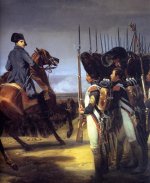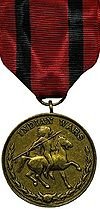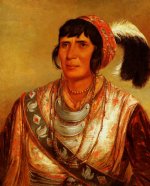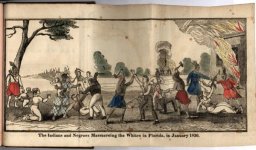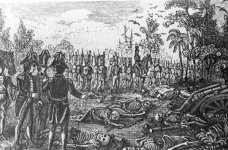The Second Seminole Indian War
1835 - 1842
Continues .....
Gentlemen - this is a big event - I actually grew up a few miles from this famous site !
 The Dade Massacre
The Dade Massacre
White settlers massacred by the Seminoles. From an 1836 book.
Illustration from an 1836 book on the murder of a woman by Seminoles
As the realization that the Seminoles would resist relocation sank in, Florida began preparing for war. The St. Augustine Militia asked the War Department for the loan of 500 muskets. Five hundred volunteers were mobilized under Brig. Gen. Richard K. Call. Indian war parties raided farms and settlements, and families fled to forts, large towns, or out of the territory altogether.
A war party led by Osceola captured a Florida militia supply train, killing eight of its guards and wounding six others. Most of the goods taken were recovered by the militia in another fight a few days later. Sugar plantations along the Atlantic coast south of St. Augustine were destroyed, with many of the slaves on the plantations joining the Seminoles.
The U.S. Army had 11 companies, about 550 soldiers, stationed in Florida. Fort King had only one company of soldiers, and it was feared that they might be overrun by the Seminoles. There were three companies at Fort Brooke, with another two expected momentarily, so it was decided to send two companies to Fort King. On December 23, 1835 the two companies, totalling 110 men, left Fort Brooke under the command of Maj. Francis L. Dade. Seminoles shadowed the marching soldiers for five days. On December 28 the Seminoles ambushed the soldiers, and wiped out the command.
Only three men survived the massacre, and one, Edwin De Courcey, was hunted down and killed by a Seminole the next day. Two survivors, Ransome Clarke and Joseph Sprague, returned to Fort Brooke. Only Clarke, who died of his wounds a few years later, left any account of the battle from the Army's perspective. Joseph Sprague was unharmed and lived quite a while longer, but was not able to give an account of the battle because he had sought immediate refuge in a nearby pond.
The Seminoles lost just three men, with five wounded. On the same day as the Dade Massacre, Osceola and his followers shot and killed from ambush Wiley Thompson and six others outside of Fort King.
Subsequently Major Ethan Allen Hitchcock was among those who found the remains of the Dade party in February. In his journal he wrote a haunting account of the discovery, then vented his bitter discontent with the conflict: "The government is in the wrong, and this is the chief cause of the persevering opposition of the Indians, who have nobly defended their country against our attempt to enforce a fraudulent treaty. The natives used every means to avoid a war, but were forced into it by the tyranny of our government.".
On December 29 General Clinch left Fort Drane (recently established on Clinch's plantation, about twenty miles (32 km) northwest of Fort King) with 750 soldiers, including 500 volunteers on an enlistment due to end January 1, 1836. They were going to a Seminole stronghold called the Cove of the Withlacoochee, what is now known as Lake Tsala Apopka, an area of many lakes on the southwest side of the Withlacoochee River.
When they reached the river, they could not find the ford, and Clinch had his regular troops ferried across the river in a single canoe they had found. Once they were across and had relaxed, the Seminoles attacked. The troops only saved themselves by fixing bayonets and charging the Seminoles, at the cost of four dead and 59 wounded. The militia provided cover as the Army troops then withdrew across the river.
On January 6, 1836 a band of Seminoles attacked the coontie plantation of William Cooley on the New River (in present-day Fort Lauderdale, Florida), killing his wife and children and the children's tutor. The other residents of the New River area and of the Biscayne Bay country to the south fled to Key West.
On January 17, volunteers and Seminoles met south of St. Augustine at the Battle of Dunlawton. The volunteers lost four men, with thirteen wounded.
On January 19, 1836 the Navy sloop-of-war Vandalia was dispatched to Tampa Bay from Pensacola. On the same day 57 marines were dispatched from Key West to help man Fort Brooke.





